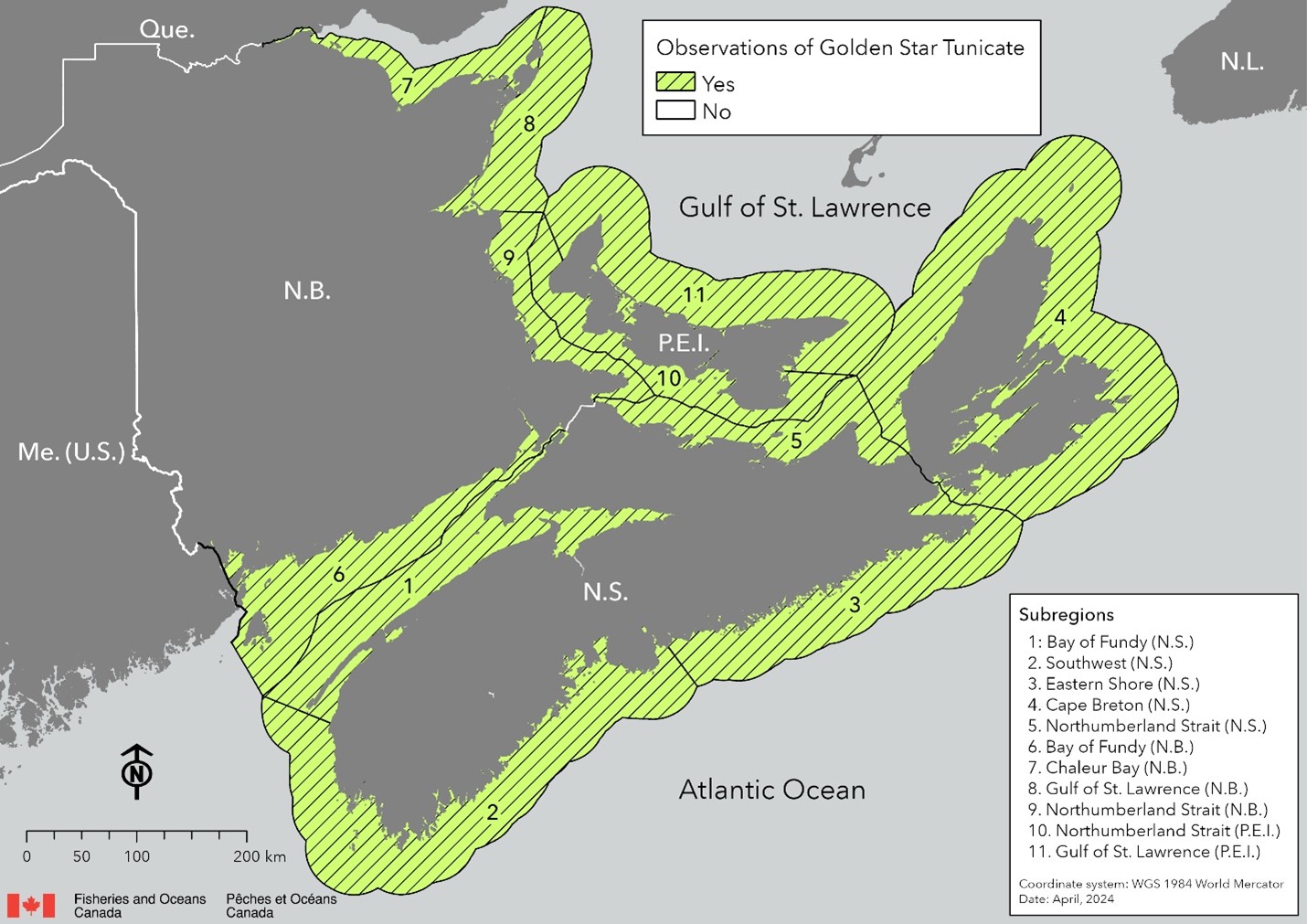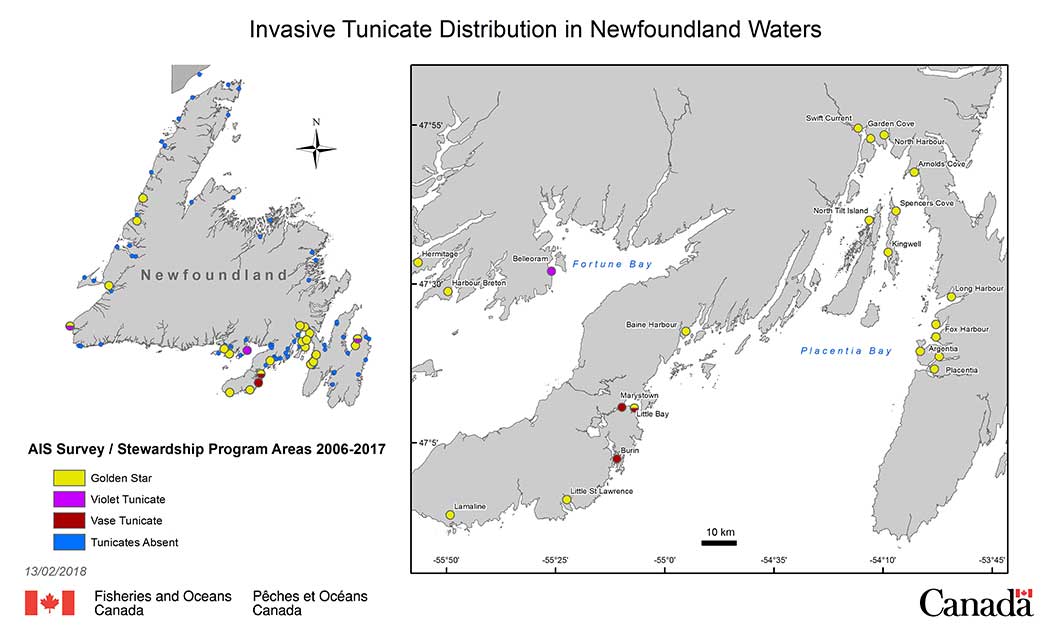Golden Star Tunicate
Botryllus schlosseri
Report it
If you think you have found an aquatic invasive species:
- do not return the species to the water
- take photos
- note:
- the exact location (GPS coordinates)
- the observation date
- identifying features
- contact us to report it
Golden Star Tunicate is an invasive colonial tunicate widely distributed throughout the world. It has been reported in eastern Canada and in the Gulf of St. Lawrence for several decades.
On this page
- Origin and distribution
- Identifying features
- Ecological and economic impacts
- Mode of arrival and dissemination
- Government action
- Golden Star Tunicate in Newfoundland and Labrador waters
- For further information
- References
Origin and distribution

Observed distribution of Golden Star Tunicate in subregions of Canada's Maritime provinces.
Note: Observation within a subregion does not mean the species is found throughout it. Lack of observation within a subregion does not mean the species is absent from that subregion. It means that it has not been observed there.
Golden Star Tunicate is native to the Mediterranean Sea and possibly the east coast of the United States, but is now found on all continents except Antarctica.
The Golden Star Tunicate has been observed on the east and west coast of Canada. On the east coast, it is now widely distributed throughout:
- Nova Scotia
- Prince Edward Island
- New Brunswick
In Newfoundland and Labrador, Golden Star Tunicate was first reported in Bonne Bay on the west coast around 1975. Approximately 30 years later, this species was confirmed at a number of sites along the south coast of the island of Newfoundland.
On the west coast, this tunicate has been reported in the Strait of Georgia and the west coast of Vancouver Island.
Identifying features
- Colour variable:
- orange
- yellow
- red
- greenish grey
- violet
- dark grey
- or black
- Dense colonies of several small (1 to 2 millimetres) individuals
- Individuals that make up the colony form flower or star-shaped arrangements
- Colony may reach 10 centimetres in size
Colonies are typically densely packed into a mat that covers the underlying surface. Where space is limited, they may grow in lobes, with single layers of individuals folding over one another.
Similar species (native)
Can be mistaken for sponges, but sponges have a soft porous texture rather than a gelatinous one.
Ecological and economic impacts
Golden Star Tunicate is a filter feeder, getting nutrients from phytoplankton (algae), bacteria and other small organic things that float in the sea. In large numbers, the tunicate competes for food with other filter feeders, such as mussels and scallops.
Golden Star Tunicate is mostly composed of water. It grows rapidly and may cover surrounding plants and animals, depriving them of sunlight or food. Golden Star Tunicate may even suffocate smaller organisms such as juvenile mollusks, and may cause organisms that attach to marine surfaces to be more vulnerable to being moved by water currents. All of this makes the Golden Star Tunicate disruptive to shellfish harvesters, aquaculture farmers, and aquatic organisms that live on the bottom of the ocean.
Mode of arrival and dissemination
The Golden Star Tunicate was likely introduced to Atlantic Canada by human transport, such as aquaculture transfers, hull fouling and tunicate fragments in ballast water of boats. It reproduces in 2 ways:
- when fragments of a colony break off and bud elsewhere
- by the production of eggs that hatch into free-swimming larvae
Both fragments and larvae settle and grow on a range of artificial and natural surfaces such as:
- buoys
- boat hulls
- rope
- wharf pilings
- floating docks
- rocks
- mussels
- kelp
Larvae released into the water column settle within 24 to 48 hours, and only travel over small distances. Colony fragments may reproduce for up to 40 days and may disperse over much greater distances. Colonies grow once water temperatures exceed 6º C. Egg production, larval development, and growth start at water temperatures greater than 12º C. During the winter, when water temperatures drop below 6º C, colonies may enter a resting phase, reduce in size or die. Transport of free-swimming larvae in the ballast water of ships is unlikely because of their short larval cycle, but ballast may contain floating debris that could serve as a vector for adult forms.
Government action
Scientific research
As the ocean grows warmer, it is important to continue to monitor any changes in the Golden Star Tunicate's distribution and range expansion. Fisheries and Oceans Canada is monitoring the distribution of invasive biofouling species (that is, aquatic species that live attached to hard surfaces) on the Atlantic and Pacific coasts to detect new invasions and track the spread of Golden Star Tunicate.
Golden Star Tunicate in Newfoundland and Labrador waters
Controlling abundance

Click images to enlarge.
Distribution Location and Bay
- Argentia
- Arnolds Cove
- Baine Harbour
- Bonne Bay
- Codroy
- Fox Harbour
- Foxtrap
- Garden Cove
- Harbour Breton
- Hermitage
- Kingwell
- Lamaline
- Little Bay
- Little Port Harmon
- Little St Lawrence
- Long Harbour
- Long Pond
- Marystown
- NE Arm Placentia
- North Harbour
- North Tilt Island
- SE Arm Placentia
- Spencers Cove
- St Pauls Inlet
- Swift Current
Tunicates can spread through the movement of:
- fishing gear
- shellfish
- recreational and commercial vessels
To prevent the spread of Golden Star Tunicate, boats and other gear should be visually inspected and properly cleaned, drained and allowed to dry for 7 days. Also, because Golden Star Tunicate can rapidly colonize and establish large, self-sustaining populations, it should be removed from wharves and surrounding structures.
When combined with surveys (see map of where the Golden Star Tunicate are located), using genetic tools to find eggs and larvae of Golden Star Tunicate will help target control and prevention efforts. Improving our understanding of its lifecycle will help us to establish where and when to apply these efforts. Especially important is the removal of Golden Star Tunicate before it reproduces each year. Recent work by Memorial University of Newfoundland and Fisheries and Oceans Canada at Arnold's Cove indicates the reproduction cycle starts in late July and continues through early October.
For further information
- Canadian Science Advisory Secretariat (CSAS) Publications
- Invasive Tunicate - Fact Sheet
- Biological Synopsis of the colonial tunicates, Botryllus schlosseri and Botrylloides violaceus (PDF, 1,162 KB) Fisheries and Oceans Canada – 2006
- Aquatic Invasive Species: Golden Star Tunicate in Newfoundland and Labrador Waters Fisheries and Oceans Canada – 2011
- Science advice from a risk assessment of five sessile tunicate species (CSAS SAR - 2012/049)
References
Berrill, N.J. 1950. The Tunicata, with an account of the British species. Ray Society, London. Publication 133: iii + 354 p.
Callahan, A.G., Deibel, D., McKenzie, C.H., Hall, J.R., et Rise, M.L. 2010. Survey of harbours in Newfoundland for indigenous and non-indigenous ascidians and an analysis of their cytochrome c oxidase I gene sequences. Aquat Inv 5: DOI 10.339/ai2010.5.1.
Hooper, R. 1975. Bonne Bay marine resources. An ecological and biological assessment. Mans Rep, Parks Can Atl Reg Office. 295 p.
- Date modified:





